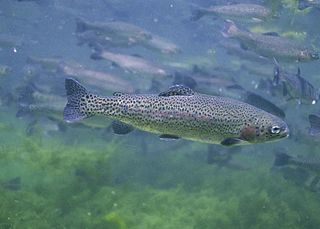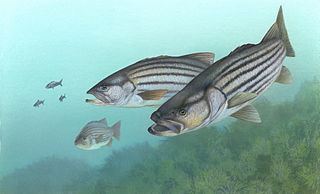
Trout is a generic common name for numerous species of carnivorous freshwater ray-finned fishes belonging to the genera Oncorhynchus, Salmo and Salvelinus, all of which are members of the subfamily Salmoninae in the family Salmonidae. The word trout is also used for some similar-shaped but non-salmonid fish, such as the spotted seatrout/speckled trout.

The white bass, silver bass, or sand bass is a freshwater fish of the temperate bass family Moronidae. commonly around 12-15 inches long. The species' main color is silver-white to pale green. Its back is dark, with white sides and belly, and with narrow dark stripes running lengthwise on its sides. It has large, rough scales and two dorsal fins. They are widely distributed across North America, inhabiting large reservoirs and rivers. When mating in the spring, they are more often found in shallow rivers, creeks, and streams. They have been introduced in some places as sport fish and also to predate on nuisance fish, such as gizzard shad. It is the state fish of Oklahoma.
The American pickerels are two subspecies of Esox americanus, a medium-sized species of North American freshwater predatory fish belonging to the pike family :

The striped bass, also called the Atlantic striped bass, striper, linesider, rock, or rockfish, is an anadromous perciform fish of the family Moronidae found primarily along the Atlantic coast of North America. It has also been widely introduced into inland recreational fisheries across the United States. Striped bass found in the Gulf of Mexico are a separate strain referred to as Gulf Coast striped bass.

The muskellunge, often shortened to muskie,musky, ski, or lunge, is a species of large freshwater predatory fish native to North America. It is the largest member of the pike family, Esocidae.

The northern pike is a species of carnivorous fish of the genus Esox (pikes). They are commonly found in moderately salty and fresh waters of the Northern Hemisphere. They are known simply as a pike in Great Britain, Ireland, most of Eastern Europe, Canada and the U.S., although in the Midwest, they may be called a Northern.

The brown trout is a species of salmonid ray-finned fish and the most widely distributed species of the genus Salmo, endemic to most of Europe, West Asia and parts of North Africa, and has been widely introduced globally as a game fish, even becoming one of the world's worst invasive species outside of its native range.

Esox is a genus of freshwater fish commonly known as pike or pickerel. It is the type genus of the family Esocidae. The type species of the genus is Esox lucius, the northern pike.

The tiger muskellunge, commonly called tiger muskie, is a carnivorous fish, and is the usually sterile, hybrid offspring of the true muskellunge and the northern pike. It lives in fresh water and its range extends to Canada, the Northeast, and the Midwest United States. It grows quickly; in one study, tiger muskie grew 1.5 times as fast as muskellunge. Like other hybrid species, tiger muskie are said to have "hybrid vigor," meaning they grow faster and stronger than the parent fish, and are also less susceptible to disease. Trophy specimens weigh about 14 kg (30 lb). Its main diet is fish and small birds. The tiger muskie and the muskie are called the fish of 10,000 casts due to the challenge involved in catching them.

The Lehigh River is a 109-mile-long (175 km) tributary of the Delaware River in eastern Pennsylvania. The river flows in a generally southward pattern from the Pocono Mountains in Northeastern Pennsylvania through Allentown and much of the Lehigh Valley before joining the Delaware River in Easton.

The rainbow trout is a species of trout native to cold-water tributaries of the Pacific Ocean in Asia and North America. The steelhead is an anadromous (sea-run) form of the coastal rainbow trout(O. m. irideus) or Columbia River redband trout (O. m. gairdneri) that usually returns to freshwater to spawn after living two to three years in the ocean. Freshwater forms that have been introduced into the Great Lakes and migrate into tributaries to spawn are also called steelhead.

The chain pickerel is a species of freshwater fish in the pike family of order Esociformes. The chain pickerel and the American pickerel belong to the Esox genus of pike.

The Chinook salmon is the largest and most valuable species of Pacific salmon. Its common name is derived from the Chinookan peoples. Other vernacular names for the species include king salmon, Quinnat salmon, Tsumen, spring salmon, chrome hog, Blackmouth, and Tyee salmon. The scientific species name is based on the Russian common name chavycha (чавыча).

The June sucker is an endangered species of fish endemic to Utah Lake and the Provo River in the U.S. state of Utah. It is named after the month in which it spawns. It is a gray or brownish fish with a paler belly, growing up to about 24 in (61 cm). It lives alongside the Utah sucker, which has a much wider range. Due to the populations of both fish becoming greatly reduced in the lake as a result of fishing, other species such as the common carp have been introduced into the lake. As a result, the June sucker has become "critically endangered" as the pure species is lost as a result of hybridization with the Utah sucker, and predatory fish feed on its larvae. Conservation measures have been put in place and fish are being raised in a fish hatchery for reintroduction.

Barbels are group of carp-like freshwater fish, almost all of the genus Barbus. They are usually found in gravel and rocky-bottomed moderate-flowing rivers with high dissolved oxygen content, known as the Barbel zone. A typical adult barbel can range from 25 to 240 cm in length and weigh between 200 g (7.1 oz) and 200 kg (440 lb), depending on species.

The Sanpoil River is a tributary of the Columbia River, in the U.S. state of Washington. The river is named for the Sanpoil, the Interior Salish people who live along the river course. The name is from the Okanagan term [snpʕʷílx], meaning "people of the gray country", or "gray as far as one can see".

Striped bass are perciform fish found all along the Atlantic coast, from Florida to Nova Scotia. A distinct strain has historically existed in the Gulf of Mexico, but the fishery that exists there today is for stocked or reservoir-escapee fish. Striped bass are of significant value as sporting fish, and have been introduced to many areas outside their native range.

Fish stocking is the practice of releasing fish that are artificially raised in a hatchery into a natural body of water, to supplement existing wild populations or to create a new population where previously none exists. Stocking may be done for the benefit of commercial, recreational or tribal heritage fishing, but may also be done for ecological conservation to restore or increase the population of threatened/endangered fish species that is pressured by prior overfishing, habitat destruction ,and/or competition from invasive species.
The Aquitanian pike is a species of pike, a predatory fish native from the Charente to the Adour river drainages in the French Great South-West region. It was scientifically described in 2014, but had formerly been regarded as a population of the widespread northern pike. The two species generally resemble each other and they are able to hybridize. This represents as threat to the relatively localized Aquitanian pike, as northern pikes commonly have been used to stock places previously only inhabited by the Aquitanian pike; historically, the two had fully separated distributions.

The Chesapeake logperch is a small species of freshwater ray-finned fish, a darter from the subfamily Etheostomatinae, part of the family Percidae, which also contains the perches, ruffes and pikeperches. It is found in the Chesapeake Bay drainages. It prefers gravel runs and riffles of small to medium-sized rivers.

















